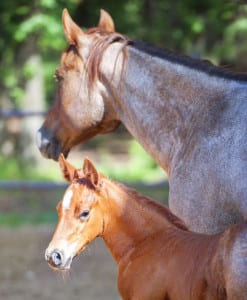Maybe you’re like me and your autumn has been consumed with dreaming about “the magic cross.” My family has several little mares in mind to breed this coming spring, and there is so much to keep in mind these days as a mare owner! Between the genetic panel tests to order, breeding contracts to pore over, deworming and nutrition to keep in mind … yeesh, it’s a never-ending list. To get your broodmare prepped for spring, be sure to use these 14 tips.
1. Start your stallion search in the fall. By thoroughly researching your favorite stallions and making your selection early, you increase your chances of booking the stallion you really want.
2. Focus on the four most important things when searching for the right stallion. Those are pedigree, conformation, the stallion’s performance records and prepotency.
3. The right breeding contract between a stallion and a mare owner can prevent a number of foreseeable problems. If you are breeding a mare this season, be sure that the party presenting the contract and signing it has the authority to do so, and double-check that the contract specifies a range of dates or months in which the stallion is available.
 4. Complete a genetic panel test and compare the results to those of the stallion you are considering. Thanks to decades of research, we now know that defects in inheritable genes are responsible for some of the diseases that afflict some American Quarter Horses. Fortunately, genetic tests have been developed to help breeders identify affected horses, allowing them to make better decisions and avoid perpetuating these traits. AQHA now offers a panel test for five genetic diseases.
4. Complete a genetic panel test and compare the results to those of the stallion you are considering. Thanks to decades of research, we now know that defects in inheritable genes are responsible for some of the diseases that afflict some American Quarter Horses. Fortunately, genetic tests have been developed to help breeders identify affected horses, allowing them to make better decisions and avoid perpetuating these traits. AQHA now offers a panel test for five genetic diseases.
5. Is the stallion AQHA Incentive Fund-nominated? Having a foal that is eligible for the Incentive Fund can mean the world to the marketability. If your aim is for a return on your investment, be sure that the stallion you are breeding to is enrolled in the AQHA Incentive Fund.
6. Consider the risks of breeding an older maiden mare. The inherent fertility of mares remains high until approximately 12 to 15 years of age, after which there is a slow progressive decline in pregnancy and foaling rates until mares are in their mid- to late 20s.
7. Know the difference between anestrus and estrus. During winter, a mare’s reproductive system goes into anestrus: The system shuts down its hormonal activity and ovulation cycles in response to the shorter day length perceived by the eye and interpreted by the pineal and pituitary glands. As the days in spring lengthen, the mare’s reproductive system gears back into action – known as estrus.
8. Put your mare under lights. Doing so in the winter months can help lengthen her days and jump start her reproductive cycle. It is one of the few factors that can be controlled in a reproductive schedule.
9. Know that prudent use of the progestin Regumate can be beneficial. A majority of mares have limited ovarian follicular development and do not exhibit estrus, or heat, during the winter months. Consult your veterinarian to see if the use of Regumate might be beneficial to manage your mare’s reproduction system.
10. Get a complete reproductive exam of your broodmare before breeding season. This will head off any potential problems. This will include a physical inspection of the reproductive tract, along with an ultrasound exam.
11. Make sure your mare’s nutrition requirements are met to increase her chance of being bred. Causes of failure to show heat or failure to cycle include inadequate nutrition or poor body condition. Mares in poor body condition are more prone to begin to cycle later in the spring than mares on a good plane of nutrition.
12. Is coat color a f actor for you? AQHA now offers a coat color test and individual color tests, allowing horse owners to determine the actual coat color of a horse. Once you know your mare’s actual coat color, and if you know that of the stallion, you can work with one of AQHA’s coat color experts to determine the coat color possibilities from that cross.
actor for you? AQHA now offers a coat color test and individual color tests, allowing horse owners to determine the actual coat color of a horse. Once you know your mare’s actual coat color, and if you know that of the stallion, you can work with one of AQHA’s coat color experts to determine the coat color possibilities from that cross.
13. Do you already have the perfect name picked out? There’s no sense in waiting until the foal is born, just to find out that someone has snatched up your brilliant name. AQHA can reserve a registered name for you.
14. Be a responsible steward of the America Quarter Horse’s future. Too often, owners feel obligated to breed their mare. Horse owners should be happy with their mare in the first place and not expect a stallion’s genes to do all the work to clean up conformation flaws, athleticism and disposition.
Did you like these tips? You can sign up to receive weekly horse-breeding e-newsletters from America’s Horse Daily, or visit www.americashorsedaily.com to browse the robust educational resource dedicated to your horse-related interests and activities.








